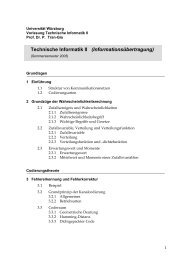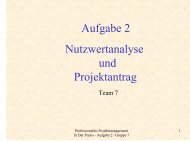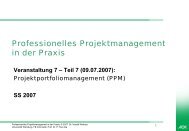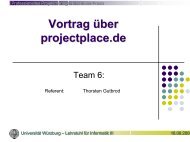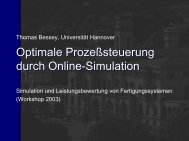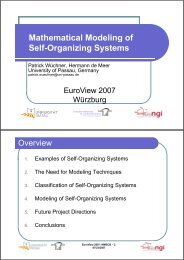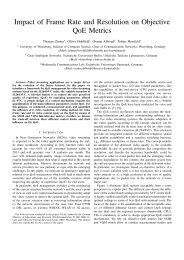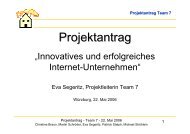Measurement and Analysis of Skype VoIP Traffic in 3G UMTS Systems
Measurement and Analysis of Skype VoIP Traffic in 3G UMTS Systems
Measurement and Analysis of Skype VoIP Traffic in 3G UMTS Systems
Create successful ePaper yourself
Turn your PDF publications into a flip-book with our unique Google optimized e-Paper software.
orig<strong>in</strong>al4.50wav-fileencodedecodesound has to be forwarded toanother mach<strong>in</strong>e <strong>in</strong> order tosave it to a wav-file on diskdegeneratedwav-file 4.02audio cablereceivedwav-file 3.93Figure 6: Reference PESQ value without <strong>in</strong>fluence <strong>of</strong> networkThe network-based factors which <strong>in</strong>fluence the perceived voice quality are the received throughput,the packet loss, the delay, <strong>and</strong> the delay jitter. The throughput <strong>in</strong>cludes the payload as wellas the UDP <strong>and</strong> IP headers. The headers <strong>of</strong> the data l<strong>in</strong>k layer <strong>and</strong> the physical layer are neglected<strong>in</strong> order to compare the throughputs <strong>in</strong> the bottleneck LAN scenario <strong>and</strong> <strong>in</strong> the <strong>UMTS</strong>scenario. The jitter is described by the packet <strong>in</strong>terarrival time (PIT), i.e. the time differencebetween two consecutive packet arrivals.While it is a trivial task to measure the network-based factors by captur<strong>in</strong>g a packet traceat the receiver, the factors have to be mapped to a value describ<strong>in</strong>g the <strong>in</strong>fluence <strong>of</strong> the networkon the speech quality. The PESQ reduction imposed by the network connectivity betweensender <strong>and</strong> receiver is described by the Network Utility Function (NUF) U Netw <strong>in</strong>troduced <strong>in</strong> [4]:PESQ rcvd ≃ U Netw · PESQ sent . In general, the NUF consists <strong>of</strong> a number <strong>of</strong> factors, eachreflect<strong>in</strong>g an impairment on the quality, U Netw = ∏ i U i U ∈ {0, 1} . In [4] the latter is concretisedas U Netw = U m · U s . The factor U m is called m-Utility Function (m-UF) <strong>and</strong> captureschanges <strong>of</strong> the mean throughput dur<strong>in</strong>g an observation w<strong>in</strong>dow <strong>of</strong> duration ∆W{from m sent } atthe sender to m rcvd at the receiver, which is reflected by the loss ratio l = max 1 − m rcvdm sent, 0 .The factor U s is denoted as s-Utility Function (s-UF) <strong>and</strong> captures changes <strong>of</strong> the st<strong>and</strong>ard deviation<strong>of</strong> the throughput from s sent to s rcvd also dur<strong>in</strong>g an observation w<strong>in</strong>dow ∆W . Thethroughput values used for calculat<strong>in</strong>g the st<strong>and</strong>ard deviation are averages dur<strong>in</strong>g short <strong>in</strong>tervals<strong>of</strong> duration ∆T . The relative change <strong>of</strong> the st<strong>and</strong>ard deviation is denoted by σ = s rcvds sent− 1 . Theconcrete application <strong>of</strong> the NUF concept will be discussed <strong>in</strong> Section 4.3.4 <strong>Measurement</strong>s <strong>and</strong> Results<strong>Skype</strong> uses different codecs to ma<strong>in</strong>ta<strong>in</strong> reasonable call qualities at an available b<strong>and</strong>width <strong>of</strong>at least 32 kbps [2]. In our measurements, we only observed the use <strong>of</strong> the iLBC codec [6]<strong>in</strong>dicated <strong>in</strong> the technical <strong>in</strong>formation field <strong>of</strong> the <strong>Skype</strong> application.4.1 Bottleneck LAN for Emulat<strong>in</strong>g Various Wireless Channel ConditionsIn this section we concentrate on the bottleneck LAN scenario, which is used to emulate thedynamically chang<strong>in</strong>g conditions <strong>of</strong> a <strong>UMTS</strong> system. We started with a l<strong>in</strong>k b<strong>and</strong>width <strong>of</strong> 16kbps <strong>and</strong> <strong>in</strong>creased the available b<strong>and</strong>width dur<strong>in</strong>g the <strong>Skype</strong> call to 32 kbps, 64 kbps, 128 kbps<strong>and</strong> 384 kbps respectively. Dur<strong>in</strong>g the tests, we observed that the measured PESQ values are6





